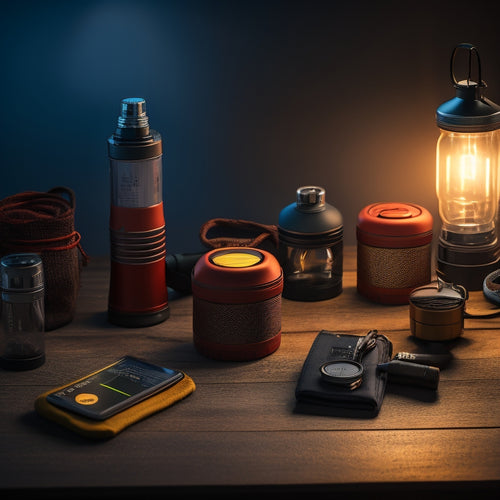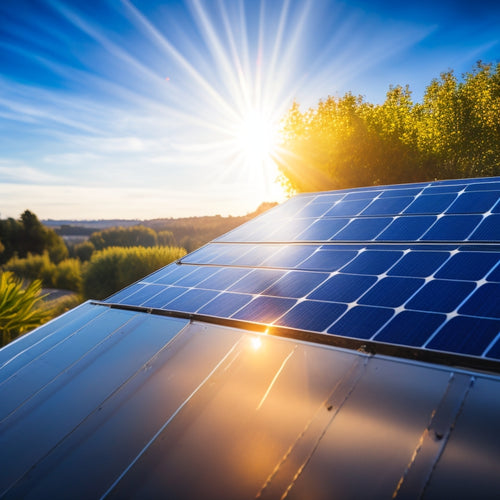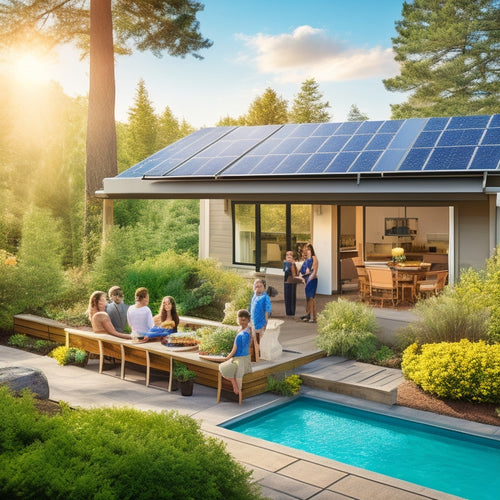
Solar Power Setup
Share
You're investing in a solar power setup to utilize the clean energy from the sun and reduce your reliance on non-renewable sources. By achieving a zero-carbon footprint, you'll neutralize your greenhouse gas emissions. Renewable energy sources like solar power grids reduce fossil fuel dependence, and government incentives promote sustainable practices. With a well-designed setup, you'll enjoy reduced energy expenses and increased disposable income. By optimizing energy output through ideal panel orientation, high-efficiency panels, and maintenance, you'll maximize energy generation. Evaluating your energy demands is essential to sizing your system accurately. Now, take the next step to access the full potential of your solar power setup.
The Essentials
- Achieve zero-carbon footprint via carbon offset strategies and solar power grids to reduce reliance on non-renewable energy sources.
- Maximize energy output by optimizing solar panel orientation, angle, and maintenance to boost energy generation and reduce bills.
- Calculate daily energy usage to accurately size the solar power system, considering factors like household appliances, usage hours, and climate.
- Silicon cells are the most efficient and widely used material in commercial solar panels, converting sunlight into energy with rates between 15% and 20%.
- Financial benefits of solar power include reduced energy expenses, increased disposable income, and government tax credits, leading to financial freedom and alignment with personal values.
Zero Carbon Footprint Guaranteed
You'll achieve a zero-carbon footprint by implementing carbon offset strategies that compensate for emissions from non-renewable energy sources.
With a Solar Power Grid, you can alleviate reliance on the grid Renewable Energy Grid and reduce energy costs over time by utilizing free and abundant solar energy.
Your solar power setup will rely on renewable energy sources, such as solar panels, to generate electricity and reduce your reliance on fossil fuels.
Carbon Offset Strategies
Implementing a carbon offset strategy is vital for individuals and organizations seeking to neutralize their environmental impact, as it enables them to compensate for their greenhouse gas emissions by investing in projects that reduce emissions elsewhere.
By purchasing carbon credits, you're supporting sustainability initiatives that promote eco-friendly practices, renewable investments, and greenhouse gas reduction. This strategy helps you achieve carbon neutrality, which is essential for climate change mitigation.
In fact, switching to Renewable Energy Solutions like solar power for your house can greatly reduce your carbon footprint. Additionally, investing in solar power systems for your residential home can provide a reliable and independent source of energy, perfect for those in areas prone to power outages or off-grid living.
To develop an effective carbon offset strategy, you'll need to calculate your carbon footprint. This involves evaluating your energy consumption, transportation, and waste management practices.
You can then invest in projects that offset your emissions, such as solar incentives, wind farms, or reforestation initiatives. By doing so, you'll be supporting energy efficiency and reducing your reliance on fossil fuels.
Renewable Energy Sources
Utilizing renewable energy sources is an important step towards achieving a zero-carbon footprint. You're not limited to solar power when it comes to reducing your reliance on fossil fuels. Other options include geothermal energy, which captures heat from the Earth's core, and wind power, which converts wind kinetic energy into electricity.
Hydroelectric systems, which generate power from moving water, are another viable alternative. Biomass energy, derived from organic matter, and tidal energy, which utilizes ocean tides, can also greatly reduce your carbon footprint.
Additionally, a well-designed solar system for off-grid living can provide a consistent and renewable energy source, alleviating concerns about fueling generators or relying on expensive and polluting alternative energy methods Off Grid Solar.
To maintain a steady supply of power, energy storage solutions are vital. This is where solar thermal systems come in, providing a reliable source of heat and electricity.
Fortunately, governments and organizations offer renewable incentives to encourage individuals and businesses to adopt sustainable practices. By investing in eco-friendly technologies, you're not only reducing your carbon footprint but also contributing to a cleaner, healthier environment.
Low Energy Bills Guaranteed
You'll greatly reduce your energy expenses by utilizing solar power, which translates to lower energy bills each month.
By cutting your reliance on grid electricity, you'll slash your power costs and enjoy a considerable decrease in your overall energy expenditures.
With residential solar panels, you can maximize your energy efficiency and reduce your carbon footprint.
This is especially true for eco-friendly homes that prioritize renewable energy systems.
With a solar power setup, you can expect to save a considerable amount on your energy bills, freeing up more of your budget for other essential expenses.
Reduced Energy Expenses
With a solar power setup, your reliance on traditional energy sources decreases, resulting in a significant drop in your energy expenses. This reduction in energy expenses translates to substantial energy savings, which can have a deep impact on your financial situation.
You'll enjoy financial benefits such as increased disposable income, reduced debt, and improved credit scores.
Moreover, the reduced energy expenses will also provide you with a sense of financial freedom, allowing you to allocate your resources towards more meaningful pursuits.
You'll no longer be held back by the burden of high energy bills, giving you the liberty to make choices that align with your values and goals.
Cutting Power Costs
The solar power setup's ability to generate electricity directly from sunlight leads to a drastic reduction in your power costs. With a solar power system, you'll be producing your own clean energy, which means you'll be less reliant on the grid and its fluctuating rates. This translates to significant savings on your energy bills.
| Benefits | Description |
|---|---|
| Reduced Energy Expenses | Lower your energy bills by generating your own electricity |
| Solar Incentives | Take advantage of government tax credits and rebates for going solar |
| Energy Storage | Store excess energy generated during the day for use at night or during power outages |
| Increased Energy Independence | Reduce your reliance on the grid and enjoy greater control over your energy usage |
Maximum Energy Output Mode
You'll want to maximize your solar power setup's energy output by achieving maximum power generation, which is directly tied to ideal panel orientation.
Properly aligned panels can greatly increase energy production, making the most of available sunlight.
With high-efficiency solar panels, you can boost your home's energy and reduce your electric bill.
Maximum Power Generation
Each solar panel in your setup is capable of producing a maximum amount of power, known as its peak power rating, typically measured in watts (W). This is the highest power output your panel can achieve under ideal conditions.
To maximize power generation, you'll want to guarantee your panels operate at their peak efficiency. Regular panel maintenance is essential to maintain energy efficiency. Dust, dirt, and debris can reduce your panel's performance, so clean them regularly.
Also, make certain your panels are free from shading, as even partial shading can greatly reduce power output. Proper installation and wiring also play a vital role in maximizing power generation. Verify your panels are connected in a way that minimizes energy losses.
Additionally, consider using a maximum power point tracking (MPPT) system, which can optimize energy output by identifying the maximum power point of your panels.
Optimal Panel Orientation
Your solar panels' ideal orientation is crucial for maximum energy output. When it comes to optimal panel orientation, you want to guarantee your panels are angled to capture the most sunlight throughout the day.
The ideal panel angle varies depending on your location and the time of year. In general, a tilt angle between 30° and 40° is suitable for most locations.
To maximize energy output, you'll need to make seasonal adjustments to your panel angle. During the summer months, a lower tilt angle (around 20°) allows your panels to capture more direct sunlight.
In the winter, a higher tilt angle (around 50°) helps to compensate for the lower sun angle. You can also consider using a tracking system that adjusts the panel angle automatically based on the sun's position.
Assess Your Energy Demands
You need to determine your daily energy usage to size your solar power system correctly.
To do this, you'll want to track your energy consumption patterns over a typical week or month, noting the times of day when you use the most energy.
Since you'll be relying on energy storage units to power your home during the night or on cloudy days, it's essential to have a clear understanding of your energy needs.
This will help you identify your peak energy demands and determine the required capacity of your solar power system.
Daily Energy Usage
How much energy does your household consume on a daily basis? Calculating your daily energy usage is essential in determining the size of the solar power system you need.
To get an accurate estimate, you'll need to assess your energy consumption habits and identify areas where you can improve energy efficiency. Start by looking at your past electricity bills to determine your average daily energy consumption in kilowatt-hours (kWh).
Next, make a list of all the appliances and devices in your home, including their wattage and the number of hours they're used daily. This will give you a better understanding of your energy usage patterns and help you identify opportunities to reduce your consumption.
For instance, you might find that replacing traditional incandescent bulbs with energy-efficient LED bulbs can remarkably lower your energy usage.
Energy Consumption Patterns
Energy consumption patterns vary considerably from one household to another, influenced by factors like lifestyle, climate, and occupancy. To evaluate your energy demands, you need to understand your consumption trends. Start by analyzing your daily energy usage, including the time of day you use the most energy and which appliances consume the most power. This will help you identify areas for energy efficiency improvements.
You can use smart meters or energy monitoring devices to track your energy consumption in real-time. These devices provide significant understandings into your energy usage patterns, helping you pinpoint opportunities to reduce consumption. By understanding when and how you use energy, you can optimize your energy efficiency and reduce your reliance on the grid.
As you evaluate your energy demands, consider factors like seasonal variations, occupancy rates, and appliance usage. This information will help you determine the size and type of solar power system you need to meet your energy requirements.
Silicon Cells Outperform Others
You'll find that silicon cells outperform other types of photovoltaic cells when it comes to converting sunlight into energy.
Their higher energy conversion rates are due to the unique properties of silicon, which allows them to utilize a wider range of light.
With conversion rates ranging from 15% to 20%, silicon cells offer a significant advantage over other materials.
Higher Energy Conversion
Over 95% of commercial solar panels rely on silicon cells, a demonstration of their superior energy conversion capabilities. You're likely to benefit from their high energy efficiency, which translates to more power output per unit area.
Silicon cells outperform other materials due to their ability to convert a wider range of sunlight into electrical energy. This is because silicon has a higher bandgap energy, allowing it to capture energy from a broader array of wavelengths.
When you opt for silicon cells, you're investing in solar innovations that have undergone rigorous research and development. The result is a technology that yields higher energy conversion rates, ensuring you get the most out of your solar power setup.
With silicon cells, you can expect a conversion efficiency of up to 22%, considerably higher than other materials. This means you'll generate more electricity from the same amount of sunlight, reducing your reliance on fossil fuels and your carbon footprint.
Frequently Asked Questions
Can I Install Solar Panels on My Old or Damaged Roof?
Before installing solar panels, you'll need a thorough roof assessment to identify potential issues. If your old or damaged roof isn't structurally sound, you'll need to address those installation considerations first to guarantee a safe and effective setup.
Will Solar Panels Work During a Blackout or Power Outage?
You're a captain steering through a storm, seeking a guiding light. During a blackout, your solar panels won't shine solo; they'll need a battery backup to keep the lights on, as grid connection alone won't cut it - you'll be stuck in the dark.
Do I Need to Clean My Solar Panels Regularly?
You should regularly clean your solar panels to guarantee peak energy production, as dirt accumulation reduces their efficiency; proper solar panel maintenance involves cleaning every 6-12 months, depending on environmental factors, to maximize your energy independence.
Are Solar Panels Resistant to Extreme Weather Conditions?
You're as prepared as a fortress for the next storm, knowing that solar panels are built to withstand extreme weather conditions, boasting durability like a shield, with resilience that's steadfast in the face of torrential rains and scorching heat.
Can I Add More Panels to My Existing Solar Power Setup?
You can expand your system by adding more panels, but make certain they're compatible with your existing setup. Consider installation costs, as they'll vary depending on the number and type of panels you add, and factor in potential upgrades to your inverter or mounting system.
Final Thoughts
You've made the smart decision to switch to a solar power setup. Now, you can rest confident that your carbon footprint is zero, and your energy bills will be considerably lower. By optimizing your system's performance in maximum energy output mode, you'll reap the benefits of silicon cells outperforming other technologies. Yes, the initial investment may seem steep, but with the long-term savings and environmental benefits, it's a worthwhile expenditure. Plus, our experts will assess your energy demands to guarantee a customized solution that meets your unique needs.
Related Posts
-

Best Solar Powered Flashlights for Emergency Situations
When you're choosing the best solar-powered flashlights for emergency situations, focus on their brightness, battery ...
-

How Efficient Are Thin Film Solar Cells
Thin film solar cells provide an innovative approach to energy generation, boasting efficiency rates generally betwee...
-

Top-Rated Home Solar Power Kits for Achieving Energy Independence
Top-rated home solar power kits enable you to achieve energy independence by greatly cutting your energy costs. You c...


